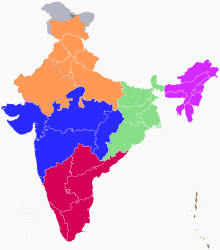National Grid (India)

The National Grid is the high-voltage electric power transmission network in mainland India, connecting power stations and major substations and ensuring that electricity generated anywhere in mainland India can be used to satisfy demand elsewhere. The National Grid is owned, operated, and maintained by state-owned Power Grid Corporation of India. It is one of the largest operational synchronous grids in the world with 307.8 GW of installed power generation capacity.
India's grid is connected as a wide area synchronous grid nominally running at 50 hertz. The permissible range of the frequency band is 49.7-50.2 Hz, effective 17 September 2012. The Union Government regulates grid frequency by requiring States to pay more when they draw power at low frequencies.[1] There are also synchronous interconnections to Bhutan, and asynchronous links with Bangladesh and Nepal.[2] An interconnection with Myanmar,[3] and an undersea interconnection to Sri Lanka (India–Sri Lanka HVDC Interconnection) has also been proposed.
The union territories of Andaman and Nicobar Islands and Lakshadweep are not connected to the National Grid. Both territories are archipelagos located far away from the mainland.[4] Due to the geography and topography of these islands, including separation by sea over great distances, there is no single power grid for all the electrified islands in the archipelago. The power generation and distribution systems of these territories is served by standalone systems, with each electrified island in the archipelago having its own generation and distribution system. Power stations cater independently to the power requirements of an area.[5][6] The Electricity Department of Andaman and Nicobar (EDA&N) and the Lakshadweep Electricity Department (LED) are responsible for generation, transmission and distribution systems in these territories.[7]
History
India began utilizing grid management on a regional basis in the 1960s. Individual State grids were interconnected to form 5 regional grids covering mainland India. The grids were the Northern, Eastern, Western, North Eastern and Southern Grids. These regional links were established to enable transmission of surplus electricity between States in each region. In the 1990s, the Indian government began planning for a national grid. Regional grids were initially interconnected by asynchronous HVDC back-to-back links facilitating limited exchange of regulated power. The links were subsequently upgraded to high capacity synchronous links.[8]
The first interconnection of regional grids was established in October 1991 when the North Eastern and Eastern grids were interconnected. The Western Grid was interconnected with the aforementioned grids in March 2003. The Northern grid was also interconnected in August 2006, forming a Central Grid synchronously connected operating at one frequency.[8] The sole remaining regional grid, the Southern Grid, was synchronously interconnected to the Central Grid on 31 December 2013 with the commissioning of the 765 kV Raichur-Solapur transmission line, thereby establishing the National Grid.[9][8]
References
- ↑ Bhaskar, Utpal. "CERC plans to further narrow frequency band for national grid". Livemint. Retrieved 2 December 2016.
- ↑ "Grid Security – Need For Tightening of Frequency Band & Other Measures" (PDF). Central Electricity Regulatory Commission. Retrieved 2 December 2016.
- ↑ Bhaskar, Utpal (1 January 2014). "India is now one nation, one grid". Livemint. Retrieved 2 December 2016.
- ↑ "Renewable Energy". Department of Electricity, UT of Lakshadweep. Retrieved 2 December 2016.
- ↑ "Power Department". Andaman and Nicobar Administration. Retrieved 2 December 2016.
- ↑ "Power for All - Andaman and Nicobar" (PDF). Ministry of Power. Retrieved 2 December 2016.
- ↑ "DEPARTMENT AT A GLANCE". electricity.and.nic.in. Retrieved 2 December 2016.
- 1 2 3 "One Nation-One Grid". Power Grid Corporation of India. Retrieved 2 December 2016.
- ↑ "Indian power system becomes largest operating synchronous grid in the world". The Times of India. Retrieved 2016-12-02.